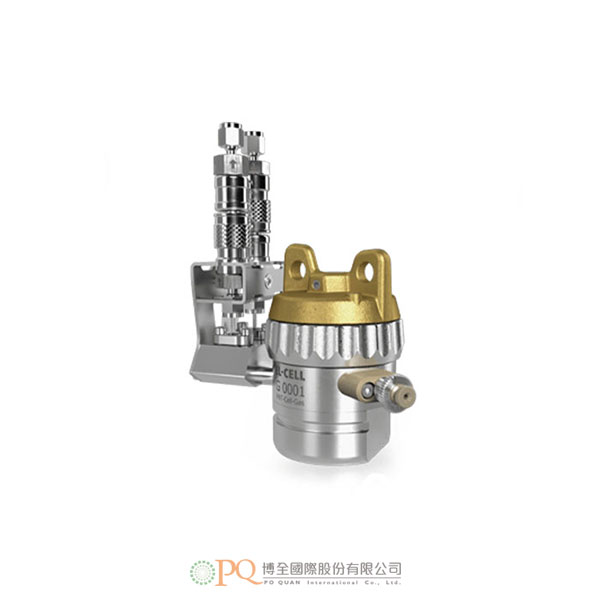
-
 AARONIA AG
AARONIA AG
-
 ADASH
ADASH
-
 Amptek
Amptek
-
 AOiP
AOiP
-
 AstroNova
AstroNova
-
 Automatic Research
Automatic Research
-
 AWSensors
AWSensors
-
 BASI
BASI
-
 BRS
BRS
-
 CALMET
CALMET
-
 CHECKLINE
CHECKLINE
-
 Cmc
Cmc
-
 C-Tech
C-Tech
-
 CTRL
CTRL
-
 DANATRONICS
DANATRONICS
-
 DV Power
DV Power
-
 EA Technology
EA Technology
-
 ECH
ECH
-
 EL-CELL
EL-CELL
-
 Electrothermal
Electrothermal
-
 Elsys
Elsys
-
 ELVEFLOW
ELVEFLOW
-
 Enapter
Enapter
-
 ENERGY SUPPORT
ENERGY SUPPORT
-
 Enervac
Enervac
-
 FASTEC
FASTEC
-
 Gaskatel
Gaskatel
-
 GE
GE
-
 GIUSSANI
GIUSSANI
-
 Globecore
Globecore
-
 GMW
GMW
-
 GREENLIGHT
GREENLIGHT
-
 GRZ
GRZ
-
 HIGH SENSE SOLUTIONSHTW
HIGH SENSE SOLUTIONSHTW
-
 HTW
HTW
-
 HUBER
HUBER
-
 HVPD
HVPD
-
 Ida
Ida
-
 Instytut Fotonowy
Instytut Fotonowy
-
 IVIUM
IVIUM
-
 Jacomex
Jacomex
-
 Jenway
Jenway
-
 JGG
JGG
-
 KEHUA TECH
KEHUA TECH
-
 Labdex
Labdex
-
 Labnics
Labnics
-
 LIQUID
LIQUID
-
 METERTEST
METERTEST
-
 Metrel
Metrel
-
 Microrad
Microrad
-
 micrux
micrux
-
 ndb
ndb
-
 Neware
Neware
-
 Norecs
Norecs
-
 Novocontrol
Novocontrol
-
 OKOndt Group
OKOndt Group
-
 OZM
OZM
-
 Pine Research
Pine Research
-
 Redoxme
Redoxme
-
 SATIR
SATIR
-
 SDT
SDT
-
 Serstech
Serstech
-
 VacCoat
VacCoat
-
 Zurich
Zurich
- AARONIA AG
- ADASH
- Amptek
- AOiP
- AstroNova
- Automatic Research
- AWSensors
- BASI
- BRS
- CALMET
- CHECKLINE
- Cmc
- C-Tech
- CTRL
- DANATRONICS
- DV Power
- EA Technology
- ECH
- EL-CELL
- Electrothermal
- Elsys
- ELVEFLOW
- Enapter
- ENERGY SUPPORT
- Enervac
- FASTEC
- Gaskatel
- GE
- GIUSSANI
- Globecore
- GMW
- GREENLIGHT
- GRZ
- HIGH SENSE SOLUTIONSHTW
- HTW
- HUBER
- HVPD
- Ida
- Instytut Fotonowy
- IVIUM
- Jacomex
- Jenway
- JGG
- KEHUA TECH
- Labdex
- Labnics
- LIQUID
- METERTEST
- Metrel
- Microrad
- micrux
- ndb
- Neware
- Norecs
- Novocontrol
- OKOndt Group
- OZM
- Pine Research
- Redoxme
- SATIR
- SDT
- Serstech
- VacCoat
- Zurich
PAT-Cell-Gas
PAT-Cell-Gas 型號:PAT-Cell-GasPAT-Cell for in-situ gas analysis in a flow-through set-up
- PAT series test cell with gas inlet and outlet
- Lower plungers with perforated plate and with spiral-shaped flow field for optimized plug-flow available.
- Optional laser-welded pressure sensor, 0 to 3 bar abs.
-
PAT-Cell for in-situ gas analysis in a flow-through set-up
Our versatile test cell for in-situ gas analysis
The PAT-Cell-Gas is a test cell dedicated to the in-situ gas analysis of battery materials in a flow-through setup. It combines all capabilities of the ECC-Air, ECC-DEMS and PAT-Cell-Press test cells. For this purpose, the test cell features a gas inlet and outlet with self-locking couplings that are compatible with 1/16 in. Swagelok tube fittings. In addition, options that include a built-in pressure sensor or a valve port for gas sampling with a syringe are also available.The cell stack is placed on top of a perforated or grooved current collector (flow field), which is to be purged with a gentle stream of gas. The lower electrode must be porous to gas to allow for gas exchange with the feed gas. The cell is typically used with gas diffusion electrodes (such as for Li-air) or with Li-ion battery electrodes with a meshed current collector. The unique design minimizes the back mixing of the gas from the flowfield back into the headspace. It is thus very suitable for time-resolved gas analysis with a mass spectrometer, for example.
All PAT-Cell-Gas variants can be operated directly with the PAT-Tester-x potentiostat. If used with a 3rd party potentiostat, the PAT-Press-Box is required for all variants equipped with a pressure sensor.
Working modes
There are two dedicated lower plunger available for the
PAT-Cell-Gas for different testing purposes.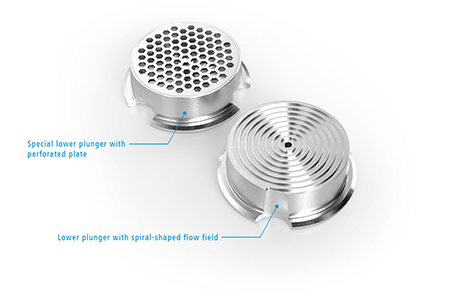
Mode 1: Air mode
The lower plunger with perforated plate allows for electrochemical characterization of gas diffusion electrodes used for instance in Li-air batteries. The lower electrode is contacted by and “breathes” through the perforated stainless steel current collector supporting it. During operation, the pressure gradient building up between cell headroom and the gas volume below the perforated plate effectively prevents back-mixing. The relatively large volume below the perforated is at the expense of time resolution, but makes this solution robust against clogging of the gas path.PAT-Core configuration example
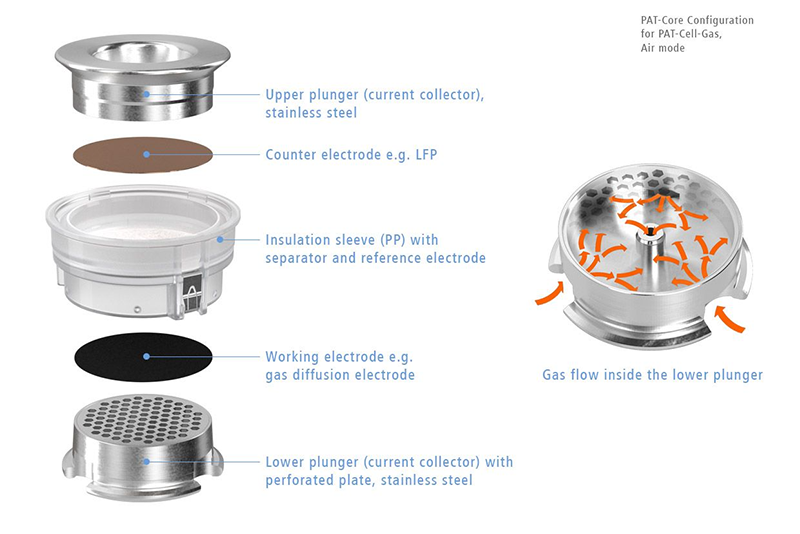
Mode 2: OEMS mode
The PAT-Core setup using a lower plunger with a flow field provides almost perfect plug-flow of the purge gas, being essential for quantitative time-resolved analysis. Gases evolved or consumed at the working electrode may be analysed through the composition change of the gas stream that is to be passed along the spiral-type flow field below the working electrode. The composition of the outgoing gas can be analyzed by e.g. mass spectrometry. The pressure gradient between cell headroom and spiral-type flow field effectively prevents back mixing. This and the tiny gas volume of the flow field ensure the best possible time resolution.PAT-Core configuration example
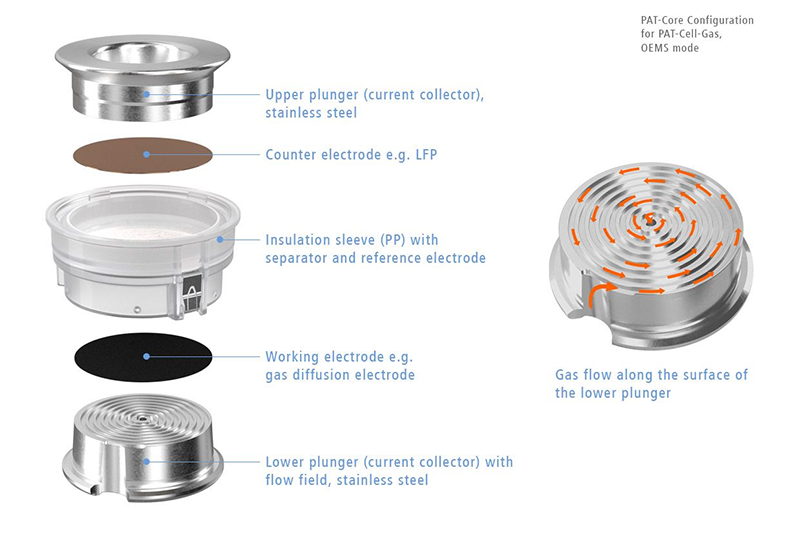
-
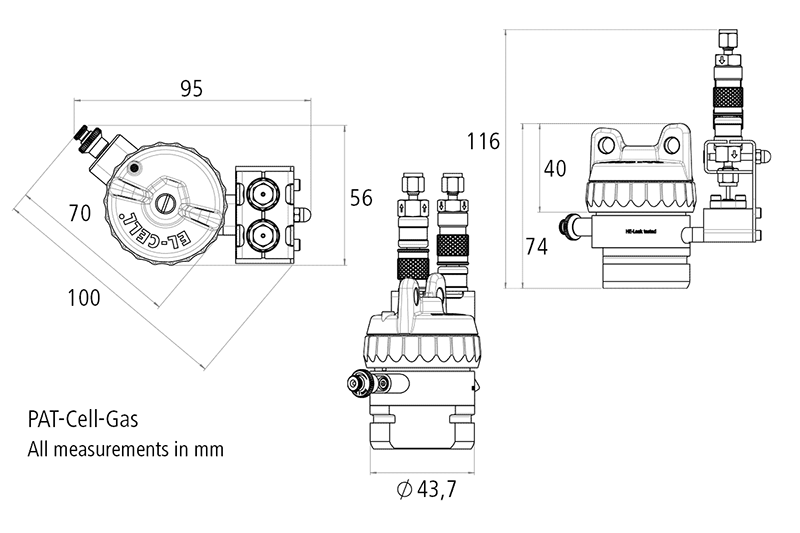
Dead volume (PAT-Cell-Gas with metal seal lid)






